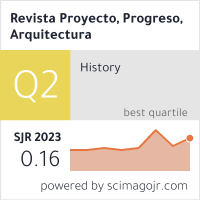VIVIENDO EN LA CIUDAD / Living in the city
DOI:
https://doi.org/10.12795/ppa.2011.i5.11Parole chiave:
ciudad, vivienda colectiva, calle, jardín, edificio, city, collective housing, street, garden, buildingAbstract
RESUMEN Es este el primer número que dedicamos a la vivienda colectiva y en parte, a la ciudad que resulta de estas edificaciones. Se puede observar a través de los artículos, el beneficio y la capacidad renovadora que tiene la vivienda colectiva cuando ésta se acomete con intención de superar los límites individuales de la vivienda o de no someterse al control económico y especulativo del mercado de la construcción.
Diferentes arquitecturas analizadas, que responden a distintos modos de vivir en la ciudad, dejan entrever la ideología social que los amparaba. Como ideología aplicada, la vivienda colectiva resultó muy operativa para lograr cambios sociales y la suma de todas esas experiencias refleja los acontecimientos que jalonaron todo el pasado siglo XX. Se podría calificar de amplia investigación colectiva que procuró no dibujar límites que la acotaran y que se empeñó en relacionar, de manera interesada, aspectos aparentemente opuestos: lo privado y lo público, la casa y la ciudad, la ciudad y el territorio, o lo artesanal y lo tecnológico.
En actualidad, la reducción del espacio público frente al privado, significa también que se altera la manera en que vive la ciudad: la vivienda colectiva se debate entre la defensa de lo individual, procurando en lo posible mantener al margen todo aquello que guarda relación con los demás, y la vida en colectividad como mejor medio de garantizar el bien común. Se busca mantener el equilibrio, transfigurando el espacio privado como público, trasladando a la vivienda y a sus edificios aquello que siempre estuvo o perteneció al espacio de la ciudad. Estas arquitecturas capaces de relacionar lo particular con lo colectivo, la vivienda con el edificio, con la ciudad, con su construcción…, suponen una constante alteración de ideas y conceptos con los que se llega a reconocer las diferentes escalas que la vivienda colectiva maneja. A esta amplia búsqueda se dedican los artículos de este número
SUMMARY This is the first issue that we have dedicated to collective housing and, in part, to the city resulting from these buildings. The articles demonstrate the benefits and the capacity for renovation of collective housing when it is undertaken with the intention of overcoming the individual limits of the dwelling, and not submitting to the financial and speculative control of the construction market.
The different architectures analysed, which respond to different ways of living in the city, hint at the social ideology that protects them. As applied ideology, collective housing was very instrumental in bringing social change, and the sum of all these experiences reflects the events that marked the entire twentieth century. It could be described as extensive collective research that attempted not to draw limiting boundaries and which was determined to concernedly relate apparently opposed aspects: the private and the public, the home and the city, the city and the land, or the traditional and the technological.
Currently, the reduction of public versus private space also means that the way the city lives is changed: collective housing is torn between protecting what is individual, making every effort to keep all that holds a relationship to others at the margin, and life in the community as the best means of ensuring the common good. It seeks balance, reshaping the private space as public, moving to the home and its buildings what was always, or pertained to, the city space. These architectures capable of relating the private to the collective, the dwelling to the building, to the city, to its construction ..., suppose a constant change of ideas and concepts with those that come to recognize the different scales that are handled by collective housing. The articles in this issue are dedicated to this broad pursuit.
Downloads
##submission.downloads##
Pubblicato
Come citare
Fascicolo
Sezione
Licenza
Las ediciones impresa y electrónica de esta Revista son editadas por el Secretariado de Publicaciones de la Universidad de Sevilla, siendo necesario citar la procedencia en cualquier reproducción parcial o total.
Salvo indicación contraria, todos los contenidos de la edición electrónica se distribuyen bajo una licencia de uso y distribución “Creative Commons Atribución-NoComercial-SinDerivar 4.0 Internacional” ![]() . Puede consultar desde aquí la versión informativa y el texto legal de la licencia. Esta circunstancia ha de hacerse constar expresamente de esta forma cuando sea necesario.
. Puede consultar desde aquí la versión informativa y el texto legal de la licencia. Esta circunstancia ha de hacerse constar expresamente de esta forma cuando sea necesario.
Los autores/as que publiquen en esta revista aceptan las siguientes condiciones:
- Los autores/as conservan los derechos de autor y ceden a la revista el derecho de la primera publicación, con el trabajo registrado con la licencia de atribución de Creative Commons, que permite a terceros utilizar lo publicado siempre que mencionen la autoría del trabajo y a la primera publicación en esta revista.
- Los autores/as pueden realizar otros acuerdos contractuales independientes y adicionales para la distribución no exclusiva de la versión del artículo publicado en esta revista (p. ej., incluirlo en un repositorio institucional o publicarlo en un libro) siempre que indiquen claramente que el trabajo se publicó por primera vez en esta revista.
- Se permite y recomienda a los autores/as a publicar su trabajo en Internet (por ejemplo en páginas institucionales o personales) antes y durante el proceso de revisión y publicación, ya que puede conducir a intercambios productivos y a una mayor y más rápida difusión del trabajo publicado (vea The Effect of Open Access).









